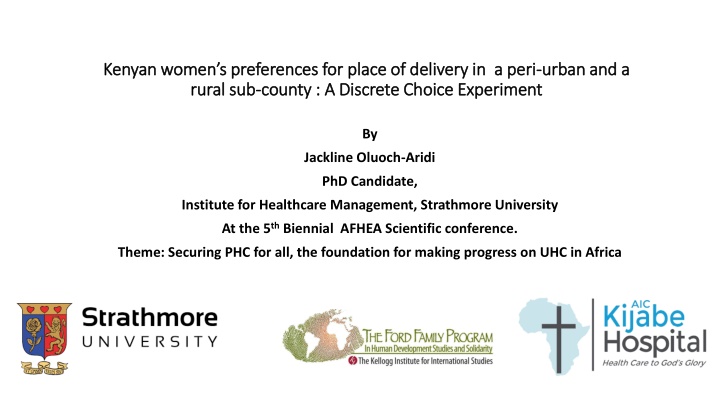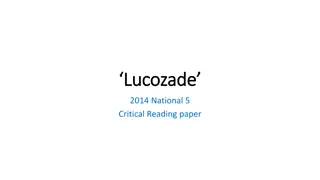
Kenyan Women's Preferences for Place of Delivery in Peri-Rural and Urban Settings
Explore the factors influencing Kenyan women's choice of delivery location through a Discrete Choice Experiment in peri-rural and urban areas. Addressing maternal mortality and increasing skilled birth attendance are crucial steps towards universal health coverage in Kenya.
Download Presentation

Please find below an Image/Link to download the presentation.
The content on the website is provided AS IS for your information and personal use only. It may not be sold, licensed, or shared on other websites without obtaining consent from the author. If you encounter any issues during the download, it is possible that the publisher has removed the file from their server.
You are allowed to download the files provided on this website for personal or commercial use, subject to the condition that they are used lawfully. All files are the property of their respective owners.
The content on the website is provided AS IS for your information and personal use only. It may not be sold, licensed, or shared on other websites without obtaining consent from the author.
E N D
Presentation Transcript
Kenyan womens Kenyan women s preferences for place of delivery preferences for place of delivery in a peri rural rural sub sub- -county county : A Discrete Choice Experiment : A Discrete Choice Experiment in a peri- -urban and a urban and a By Jackline Oluoch-Aridi PhD Candidate, Institute for Healthcare Management, Strathmore University At the 5thBiennial AFHEA Scientific conference. Theme: Securing PHC for all, the foundation for making progress on UHC in Africa
Background Background Global Context An estimated 303,000 maternal deaths globally in 2015, 66.3% of these deaths in sub-Saharan Africa (SSA) & The region has highest maternal mortality ratio globally at 900 per 100,000 livebirths. Only 47% of women deliver in a health facility in 28 SSA countries National Context Maternal mortality rate in Kenya is still unacceptably high at 362/100,000 livebirths. 43% of women in Kenya still deliver babies outside a health facility 31% of the lowest wealth quintile & 25% of women with no education deliver their babies at home without a skilled birth attendant
Maternal Mortality Maternal Mortality Deaths per 100,000 live births, Deaths per 100,000 live births, 2013 2013
Problem statement Problem statement In developing countries such as Kenya, women continue to have risky births at home without skilled birth attendance. Some women bypass primary health facilities that are closer to them to seek delivery services in further off tertiary health facilities. Understanding the persistence of maternal deaths within low income settings and women's preferences for use of delivery services can provide information that is crucial towards strengthening the health system. Skilled birth attendance serves as an indicator for health service coverage and safe facility based delivery services are essential for the drive towards universal health coverage (WHO 2015)
Study settings Study settings Naivasha (rural) & Embakasi-North (peri-urban) setting Estimated Maternal deaths in Kenya (UNFPA Report 2014) 32,021 maternal deaths in 2014, 21% of deaths from pregnancy related causes. Nairobi County (urban) ranked 3rdwith 533 maternal deaths with a maternal mortality rate (458/100,000 livebirths) Peri-Urban settlements in Nairobi have higher maternal mortality (705 per 100,000) Nakuru county (rural) ranked 4thwith 444 maternal deaths Naivasha sub-county (rural) evidence of bypass of primary health facilities to sub-County hospital (evidence from qualitative study)
Research gap Research gap Most periodic demographic health surveys and cross-sectional surveys focus on the supply side of health services and fail to address women s preferences -demand side of health services) The Kenya demographic health surveys fail to answer questions critical to the specific health concerns of the urban & rural poor. National data systems blur sub-group inequities between urban and rural areas within cities Use of stated preference methods such as Discrete Choice Experiments (DCEs) in addition to revealed preference data in health economics can be used to map preferences A DCE will provide information on other crucial non-health process indicators such as waiting time, cleanliness & non- technical quality of care indicators that are equally important in women s decision for place of delivery
Theoretical framework Theoretical framework The method of DCE s relies on the assumptions of economic rationality and utility maximization. DCE s draw from Lancaster s 1966 economic theory of value- that it is the attributes of the goods that determine the utility they provide. When an individual is stating their preference they are assumed to choose the alternative that yields his/her the highest benefit known as utility Random utility theory-The latent utility of an alternative i in a choice set Cn as perceived by an individual n is considered to be decomposable into two additively separate parts: 1) A systematic (explainable) component specified as a function of the attributes of the alternatives and 2) A random (unexplainable ) component in representation unmeasured variation in preferences . Uin=V(Xin, B) + in Discrete choice theory deals with a choice among a set of finite and mutually exclusive alternatives, the individual chooses one and only one alternative from this set Discrete choice theory introduces the idea that individual choice behavior is intrinsically probabilistic hence random
Research questions Research questions Research Question 1. What are Kenyan women s preferences for place of delivery in the Embakasi-North &Naivasha sub-County contexts? Specific Objectives Objective 1: To identify the attributes and attribute levels of place of delivery that women prefer for when choosing a place of delivery (Qualitative methods- FGD s & IDI s) Objective 2 :To determine the relative importance of the attributes & attribute levels for of place of delivery within the two contexts. (Quantitative methods-DCE) Objective 3: To determine what factors -sociodemographic variables and household characteristics influence preferences for place of delivery (Quantitative methods-DCE & Cross-sectional survey) Objective 4: To understand what trade-offs women in both settings make when they are making a decision on selecting a place of delivery. (Quantitative methods-DCE) Objective 5: To establish what the willingness to pay for the attributes when selecting a place of delivery (Quantitative methods-DCE)
Research methodology :Stages of Discrete Choice Research methodology :Stages of Discrete Choice Experiment implementation Experiment implementation Comprehensive Qualitative study Quantitative DCE Pilot DCE Literature review
A DISCRETE CHOICE EXPERIMENT(DCE) ON PREFERENCE FOR PLACE OF DELIVERY IN NAIVASHA SUB COUNTY Would like to receive the results of the study? Yes No Improving maternal health has been a key commitment of the Kenyan Government through the Ministry of Health and County Governments. If you prefer the report via email, please provide an email address here:_________________________ In 2013 a Free Maternity Services policy was initiated by a presidential decree to provide free delivery care and subsequently reduce barriers associated with receiving maternal health services. If you have any question or suggestion, please let us know. Strathmore University Institute for healthcare Management is conducting research to evaluate utilization of healthcare facilities to attempt to determine women s preferences for place of delivery using a Discrete choice experiment methodology This experiment is been conducted from women s perspective and your household has been randomly selected to participate in this survey. We want to know your preferences for place of delivery. There are no right or wrong answers. While your response is extremely important to us, your participation is voluntary. This questionnaire will take between 10 to 15 minutes to complete. Your responses will be confidential and will not be linked to you or shared with anyone. ****************** THANK YOU FOR YOUR TIME For any question about the research kindly contact: Jackline Aridi, Phone 0715961081; Email: joluocha@nd.edu Prof. Gilbert Kokwaro , Director, Institute for Healthcare Management, Strathmore Business School, Strathmore University, Phone: 0722323651 Email gkokwaro@strathmore.edu or Dr. Francis Wafula, Academic Director, Institute for Healthcare Management; Phone No: 0722679467: E-mail: fwafula@Strathmore.edu. THANK YOU FOR YOUR HELP!
Attribute 1 Option A Option B Option C II.THE DISCRETE CHOICE EXPERIMENT ON PLACE OF DELIVERY Quality of services Good quality services Poor quality services Attitude of healthcare workers Cost of delivery services Unkind attitude 5000Ksh Kind attribute 8000ksh Our objective is to conduct a DCE experiment to explore the relative importance of health service characteristics to Kenyan women living in Naivasha sub-County, Nakuru County. This will be compared to a similar cohort of women in Embakasi North in Nairobi County to try and elucidate what women s preferences are when they are selecting a place of delivery. You will be provided with a script (on a mobile phone/tablet) and you will be asked to imagine that you are pregnant and you are given a choice between the following two health facilities to deliver your baby in. Which one would you prefer? Facility A or Facility B? you also have an option of choosing none of the two health facilities as Option C. This implies delivering your baby at home. There is no right or wrong answers (None of the two health facilities/birth at home) Equipment & supplies not available Availability of equipment and supplies Equipment & supplies available Facility is far from home Facility is close to home Referral services not available Distance to health facility Availability of referral services at health facility Referral services available Your choice (tick only one) SAMPLE CHOICE CARD 2 Attribute Option A Option B Option C Good quality services Unkind attitude 8000Ksh Equipment & supplies available Attribute Health Facility A Good quality services Health Facility B Option C Quality of services Poor quality services Attitude of healthcare workers Cost of delivery services Kind attitude 3000Ksh Equipment & supplies not available Quality of services Poor quality services (None of the two health facilities/birth at home) Attitude of healthcare workers Cost of delivery services Availability of equipment and supplies Kind attitude Unkind attitude (None of the two health facilities/ Birth at home ) 3000Ksh Equipment& supplies not available Facility is close to home Referral services not available 5000Ksh Facility is close to home Facility is far from home Distance to health facility Availability of equipment and supplies Equipment & supplies available Availability of referral services at health facility Your choice (tick only one) Referral services available Referral services not available Distance to health facility Facility is far from home Referral services available Availability of referral services at health facility Your choice (tick only one) 3 Attribute Option A Option B Option C Good quality services Kind attitude 3000Ksh Quality of services Poor quality services Attitude of healthcare workers Cost of delivery services Unkind attitude 5000Ksh How certain are you about this choice? Not Certain Slightly certain Moderately certain Certain Very certain (None of the two health facilities/birth at home) Availability of equipment and supplies Equipment and supplies available Equipment and supplies not available You will see that each choice has different combination of attributes . In this example you can see Option A has good quality services, kind attitude , costing 3000Ksh and is close to home, it however lacks supplies & equipment and referral services. Option B has poor quality services, with unkind workers, is far from home and costs 5000ksh. However it has equipment and supplies and referral services . Option C means no health facility / home delivery. You are required to make trade-offs with the attributes Health facility is close to home Referral services not available Health facility is far from home Referral services available Distance to health facility Availability of referral services at health facility Your Choice (tick only one)
Qualitative Data analysis Qualitative Data analysis The qualitative data was analyzed using a thematic analysis approach (Braun & Clarke, 2013) The analysis was conducted adopting both an inductive and deductive approach. The inductive approach focused on identifying newly emergent themes/attributes from the data. The deductive approach which focused on identifying themes/attributes from the questions in the interview guides. The codes were reviewed by all authors to ensure inter coder- reliability and the authors discussed the emergent themes to reach a consensus on what to include as attributes. Nvivo 11 software was used to assist with the data analysis process
Qualitative study results : Identification of Qualitative study results : Identification of most important attributes (by frequency) most important attributes (by frequency) Table1: Frequencies for attributes identified by women during FGDs. Operation times Referral services Distance Attitude of healthcare workers Equipment & supplies Cleanliness Costs Quality of service 0 10 20 30 40 50 60 70 Attribute Frequency for Naivasha Attribute Frequency For Embakasi North
Visual representation of DCE Choice task Visual representation of DCE Choice task
Data Analysis & the Data Analysis & the Estimated utility model Estimated utility model A total of 466 women of reproductive health in the rural setting completed the DCE representing a completion rate of 83%. U in = V (Xin, ) + in Uin is the true but unobservable utility for alternative I, Vi is the observable systematic component of utility defined by the attribute levels for the alternative I Xi is a vector of attribute levels defining alternative i is a vector of estimated coefficients i is the random error component Ui = + 1 (quality _good) + 2(distance near) + 3 (attitude_kind) + 4 (drugs & supplies_avail) + 5 (cost_3000Ks) + (referral_good) + in
Rural Women's characteristics Rural Women's characteristics Characteristics Age n (mean(SD)) N(%) N(%) Characteristics Head of Household status 26 (5.0) Woman not head of household Marital status 381(82%) Single Woman head of household 57(12%) 85(18%) Married Head of HH education (n=368) 409(88%) Primary school Education (n-462) 100(27%) Primary School Secondary school 175(38%) 196(53%) Secondary School University/Some tertiary 221(48%) 72(19%) University Head of household influence 16(3%) on decision making(n=381) Not Involved in decision making Some tertiary 50(11%) 18(5%) Involved in decision making Parity 363(95%) 1 151(32%) >2 315(68%)
Results of choice model Results of choice model Parameter estimates Preference weights Std Error Lower 95% Upper 95% Term Estimate P-value Source Log Worth 0.385 0.0164 -0.418 -0.353 Attitude[Kind] 293.690 <0.001*** 0.226 0.0161 -0.258 -0.195 Attitude of hcw Equipment & Drug availability[AV] 256.360 <0.001*** Equip & drugs 132.810 <0.001*** -0.585 0.0173 0.551 0.6196 Quality of health service Quality (bad) -0.540 0.0169 0.507 0.573 Distance(Long) 46.134 <0.001*** Distance 0.122 0.0159 0.0908 0.153 Referral service[AVA] 42.021 <0.001*** No choice 13.893 <0.001*** Referral 0.0000297 0.0000097 1.0646e-5 0.0000487 Cost 2.646 0.00226** Costs -0.849 0.062 -0.971 -0.73 No Choice Indicator
Results of choice model: Likelihood ratio tests Results of choice model: Likelihood ratio tests L-R Chi-square DF Prob>ChiSq Likelihood ratio tests Quality 604.754 1 <.0001* Distance 206.663 1 <.0001* Attitude 1344.836 1 <.0001* Equipment & Drug availability Referral service 1173.059 1 <.0001* 59.412 1 <.0001* Cost 9.324 1 0.0023** No Choice Indicator 187.815 1 <.0001* AICc 11695.302 BIC 11743.794 -2*LogLikelihood 11681.287 -2*Firth Log Likelihood 11610.159
Results of DCE : Results of DCE : Likelihood tests Likelihood tests Chi Square Likelihood tests indicate that there are strong associations between the attributes and the dependent variable of place of delivery All p-values are significant therefore we can reject the null hypothesis that the attributes are not associated with choices of place of delivery The strongest association is with the attributes on attitude of health workers, followed very closely with the weakest is on referral services an lastly weak association with the attribute on costs
Policy & theoretical implications Policy & theoretical implications Policy Implications 1. Patient centered maternity care -Interactions between hcw & women. Need for transformational training 2. Equipment and supplies ave been identified in other studies elucidating preferences(Kruk and Larsen) and are crucial in preferences. 3. There is a need for focus on the quality of service on both clinical quality of management of labor and delivery 4. Distance and referral services rank lowly but still important 5. The focus on costs as a barrier is diminishing due to free maternity services but indirect costs might be a concern Theoretical Implications DCEs using Random utility theory can be tested in low-income settings Need for empirical measurement of respect and dignity during facility based delivery Use of technology to assist with visualization of attributes helps in understanding the DCE methodology Policy makers need to experimental techniques DCEs to Inform health system approaches
Selected References Selected References Lancaster, K. J. (1966). A new approach to consumer theory. The Journal of Political Economy 74(2), 132-157. Kenya National Bureau of Statistics, Ministry of Health/Kenya, National AIDS Control Council/Kenya, Kenya Medical Research Institute, Population, N. C. f., & Development/Kenya. (2015). Kenya Demographic and Health Survey 2014. Retrieved from Rockville, MD, USA: http://dhsprogram.com/pubs/pdf/FR308/FR308.pdf Kruk, M. E., Paczkowski, M., Mbaruku, G., de Pinho, H., & Galea, S. (2009). Women's preferences for place of delivery in rural Tanzania: a population-based discrete choice experiment. Am J Public Health, 99(9), 1666- 1672. doi:10.2105/ajph.2008.146209 Kruk, M. E., Paczkowski, M. M., Tegegn, A., Tessema, F., Hadley, C., Asefa, M., & Galea, S. (2010). Mangham, L. J., Hanson, K., & McPake, B. (2009). How to do (or not to do) ... Designing a discrete choice experiment for application in a low-income country. Health Policy Plan, 24(2), 151-158. doi:10.1093/heapol/czn047 Women's preferences for obstetric care in rural Ethiopia: a population-based discrete choice experiment in a region with low rates of facility delivery. J Epidemiol Community Health, 64(11), 984-988. doi:10.1136/jech.2009.087973 Ryan, M., Karen, G., & Amaya-Amaya, M. (2008). Using Discrete Choice Experiments to Value Health and Health care The Netherlands WHO, WorldBank, T., & (2015). Tracking universal health coverage: first global monitoring report. Retrieved from World Health Organization, 20 Avenue Appia, 1211 Geneva 27, Switzerland:
Acknowledgments Acknowledgments Strathmore University: Prof. Gilbert K okwaro, Dr. Frank Wafula & the PhD support group of Dr. Ben Ngoye, Tecla Kivuli and Eric Tama AIC Kijabe hospital: Dr. Mary Adams, Dr. Maureen Mchanley University of Notre Dame: Fr. Bob Dowd, my data collection team; Christine, Cindy, Brian, Sandra, Annie, Mercy, Hellen. Data analyst: Maurice Baraza & Sydney Oluoch Naivasha sub-County hospital & Embakasi-North sub County health team & Bro Andre medical centre






















